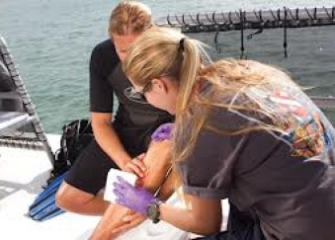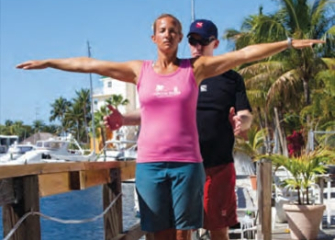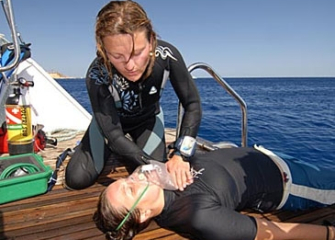The DAN Basic Life Support (BLS) course will not only train divers and non-divers to resuscitate an injured person with a circulatory arrest, but can also prevent a person from getting in that condition. External bleeding, choking and shock can lead to severe circulatory and respiratory problems. The DAN BLS course will prepare you to react in the correct way, when accidents happen.
Course Objective
The Basic Life Support course, represents entry-level training designed to educate persons in providing Basic Life Support techniques to adult victims with life threatening injuries, while activating the local medical services.
The DAN Basic Life Support provider ("DAN BLS Provider") programme is designed to teach the knowledge and skills needed to provide Basic Life Support (BLS) to adult victims. BLS consists out of several First Aid techniques that support (or might restore) life. At the end of the course the DAN BLS provider will be able to recognise an emergency, activate the EMS and provide early BLS, while waiting for an AED or Advanced Life support to arrive at the scene of the accident. Early Access to the EMS and early BLS are 2 of the 4 links in the chain of survival.
Learning Objectives
At the end of this programme, DAN Basic Life Support, course participants will be able to:
Explain basic Anatomy and Physiology.
List the 4 links of the “chain of survival”
Explain why BLS is important
State the goal of BLS and resuscitation
Recognise danger and perform a Scene Safety Assessment
Protect themselves against cross infection
Describe the function of chest compressions and ventilations
Explain how to avoid Gastric distension
Check responsiveness
Reassure an injured person
Open the airway
Check for normal breathing
Activate the EMS
Perform chest compressions and rescue breathing – CPR
List the advantages of a ace shield and resuscitation mask
Explain the advantage of oxygen during resuscitation
Explain the importance of defibrillation
State the most common cause of chocking
Describe the difference between mild and severe airway obstruction
Provide care for choking
Explain why an unconscious, breathing victim must be placed in the recovery position
Place an unconscious, breathing person in the recovery position
Describe the function of the blood
Provide care for (severe) external bleeding
Explain what is shock
Name at least 3 causes of shock
List at least 7 warning signs of shock
Provide care for injured persons in shock
Basic Life Support (BLS)

12 other people looking right now

Risk Free Purchase with 15-Day Money-Βack from your original booking and not less than 15 days from the first arranged diving day.
Questions?
Find answers and general information quickly about KosDivers courses and procedures in the FAQ section.












